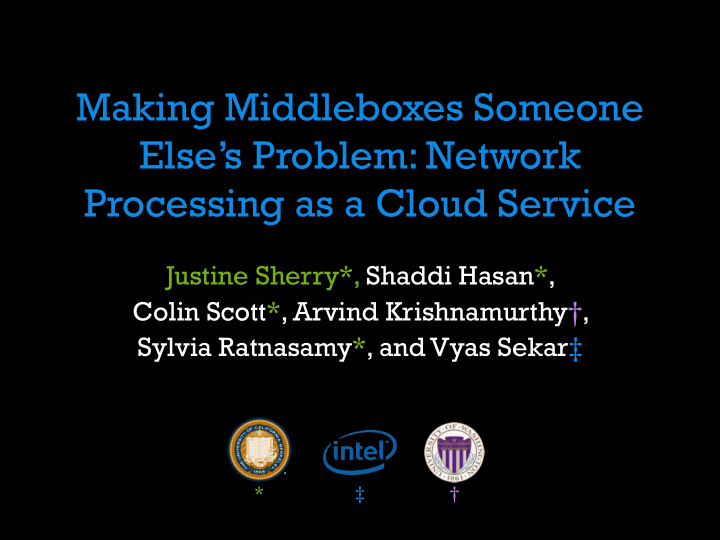



Making Middleboxes Someone Else’s Problem: Network Processing as a Cloud Service Justine Sherry*, Shaddi Hasan*, Colin Scott*, Arvind Krishnamurthy † , Sylvia Ratnasamy*, and Vyas Sekar ‡ * ‡ †
Typical Enterprise Networks Internet
Typical Enterprise Networks Internet
A Survey • 57 enterprise network administrators • Small (< 1k hosts) to XL ( >100k hosts) • Asked about deployment size, expenses, complexity, and failures.
How many middleboxes do you deploy? Typically on par with # routers and switches.
What kinds of middleboxes do you deploy? Many kinds of devices, all with different functions and management expertise required.
How many networking personnel are there? Average salary for a network engineer - $60-80k USD
How do administrators spend their time? Most administrators spent 1-5 hrs/week dealing with failures; 9% spent 6-10 hrs/week. Misconfig. Overload Physical/ Electrical Firewalls 67.3% 16.3% 16.3% Proxies 63.2% 15.7% 21.1% IDS 54.45% 11.4% 34%
Recap • High Capital and Operating Expenses • Time Consuming and Error-Prone • Physical and Overload Failures
How can we improve this?
Our Proposal Internet
Our Proposal Cloud Provider Internet
A move to the cloud • High Capital and Operating Expenses • Economies of scale and pay-per use • Time Consuming and Error Prone • Simplifies configuration and deployment • Physical and Overload Failures • Redundant resources for failover
Our Design
Challenges • Minimal Complexity at the Enterprise • Functional Equivalence • Low Performance Overhead
APLOMB “Appliance for Outsourcing Middleboxes”
Outsourcing Middleboxes with APLOMB Cloud Provider NAT Internet APLOMB Gateway
Inbound Traffic Web Server: www.enterprise.com 192.168.1.100 Cloud Provider Internet Register: www.enterprise.com 192.168.1.100 Enterprise Network Admin.
Inbound Traffic Cloud Provider 98.76.54.32 Internet Register: enterprise.com DNS 98.76.54.32
Choosing a Datacenter External Route through cloud datacenter that Client minimizes end to end latency. Cloud Provider East APLOMB Gateway keeps a “routing table” to select best tunnel for every Internet prefix. Cloud External Enterprise Provider Client West
Caches and “Terminal Services” Traffic destined to services like caches should be redirected to the nearest node. Cloud Provider West
APLOMB “Appliance for Outsourcing Middleboxes” • Place middleboxes in the cloud. • Use APLOMB devices and DNS to redirect traffic to and from the cloud. • That’s it.
Can we outsource all middleboxes? Firewalls ✔ IDSes ✔ Load Balancers ✔ VPNs ✔ ✗ Bandwidth? Proxy/Caches ✗ Compression? WAN Optimizers
APLOMB+ for Compression Add generic compression to APLOMB gateway to reduce bandwidth consumption. Cloud Provider I Internet
Can we outsource all middleboxes? Firewalls ✔ IDSes ✔ Load Balancers ✔ VPNs ✔ ✗ Bandwidth? Proxy/Caches ✔ ✗ Compression? WAN Optimizers ✔
Does it work?
Our Deployment • Cloud provider: EC2 – 7 Datacenters • OpenVPN for tunneling, Vyatta for middlebox services • Two Types of Clients: – Software VPN client on laptops – Tunneling software router for wired hosts
Three Part Evaluation Implementation & Deployment • Performance metrics Wide-Area Measurements • Network latency Case Study of a Large Enterprise • Impact in a real usage scenario
Does APLOMB inflate latency?
For PlanetLab nodes, 60% of pairs’ latency improve s with redirection through EC2.
Latency at a Large Enterprise Measured redirection latency between enterprise sites. • Median latency inflation: 1.13 ms • Sites experiencing inflation were primarily in areas where EC2 does not have a wide footprint.
How does APLOMB impact other quality metrics, like bandwidth and jitter?
• Bandwidth: download times with BitTorrent increased on average 2.3% • Jitter: consistently within industry standard bounds of 30ms
Does APLOMB negate the benefits of bandwidth-saving devices?
APLOMB+ incurs a median penalty of 3.8% bandwidth inflation over traditional WAN Optimizers.
Does “elastic scaling” at the cloud provide real benefits?
Some sites generate as much as 13x traffic more than average at peak hours.
Recap • Good application performance – Latency median inflation 1.1ms – Download times increased only 2.3% • Generic redundancy elimination saves bandwidth costs • Strong benefits from elasticity
Conclusion Moving middleboxes to the cloud is a practical and feasible solution to the complexity of enterprise networks.
What does it mean to “manage” middleboxes? • Upgrades and Vendor Interaction • Monitoring and Diagnostics • Configuration – Appliance Configuration – Policy Configuration • Training
Internal Firewalls Cloud Provider Internet
How many middleboxes can APLOMB outsource?
How much do middleboxes cost? Thousands to millions of dollars / 5 years
Is maintaining multiple tunnels at the APLOMB gateway useful?
With multiple tunnels, the fraction of pairs with 0 inflation or better moves from 40% to 60%
How large must a provider’s datacenter footprint be to support middlebox services?
Minimal Improvement to E2E Latency with Larger Footprint.
How does APLOMB redirection impact web page load times?
Median: slightly worse; 90%-ile: slightly better.
Caches may require a larger footprint to provide nationwide service.
Recommend
More recommend